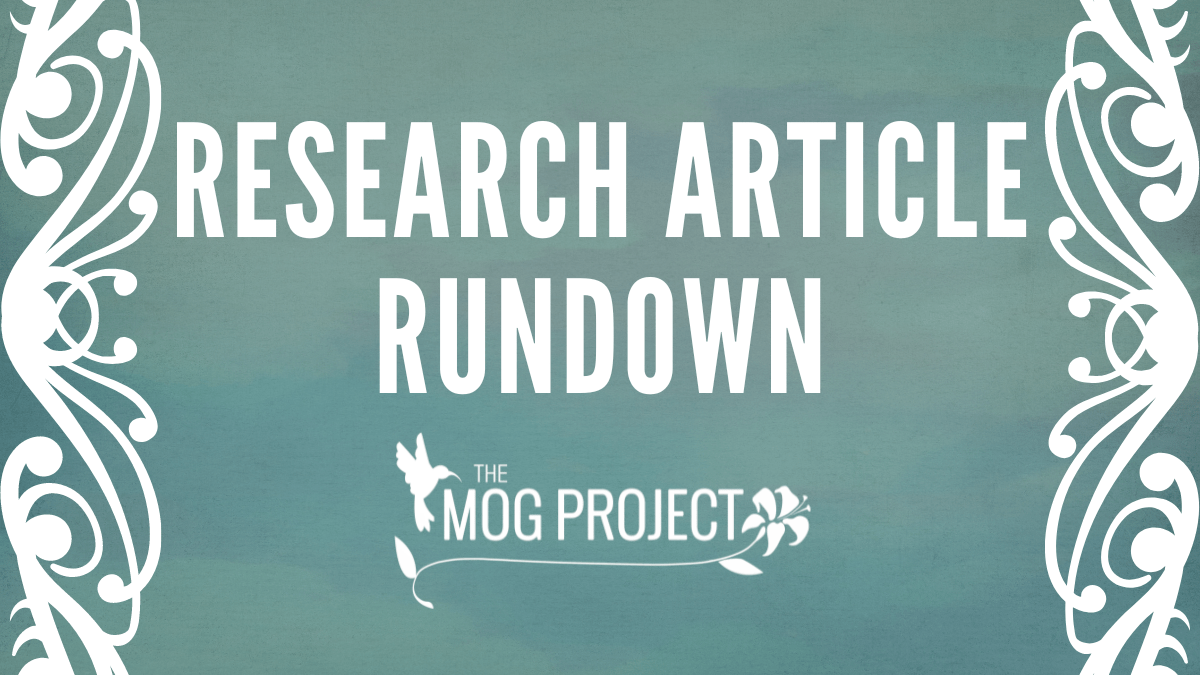In September 2022, The MOG Project was joined by doctors all over the world to talk all things MOGAD in a face-to-face question and answer panel at the Harvard Faculty Club, Cambridge, MA. Dr. Michael Levy, Dr. Sudarshini (Darshi) Ramanathan, Dr. John J. Chen, Dr. Tanuja Chitnis, Dr. Elias Sotirchos, Dr. Brenda Banwell and Dr. Jonathan Sanotoro answered 11 essential questions that we did not have time to answer during the panel discussion which originated from the MOGAD community.
On behalf of The MOG Project and the entire MOGAD community, we would like to thank these doctors and all other doctors and researchers who attended the round-table in Boston to help accelerate research in MOG Antibody Disease and continuously provide insightful information to not only the patients and their carers, but to colleagues, doctors and scientists globally. This includes: Testing for the MOG antibodies on a cell-based assay, predicting relapses, differentiating between adult and paediatric phenotypes, for the new clinical trials that have just launched for MOGAD, mood and anxiety disorders, fatigue and sleeping difficulties, effective treatment options and more!
This video presentation would not be possible without a grant from UCB Pharma Company. You can view the entire video on our YouTube Channel here as well as on our website page here under “Special Presentation Videos” which also contains a link to download a PDF of the transcript.
Questions and Answers
1. Are there any theories that vision loss can be progressive once it gets to a certain point? Some people in the community believe their vision has decreased significantly despite no clinically confirmed relapses.
There are theories that vision loss can become progressive despite no additional relapses, after a severe attack that causes a lot of damage. In this regard, it is similar to other severe optic nerve injuries. There are not many patients where this occurs with MOG antibody disease, but there may be some. In addition, patients with optic nerve damage will notice significant fluctuations in their vision from hour-to-hour due to being more sensitive to different lighting conditions, etc.
2. When a patient presents with possible relapse symptoms but they show no signs of active disease on their MRI, what are the recommended next steps to confirm the symptoms are tied to MOGAD vs. a different disease or another medical condition?
There is no set workup in this circumstance, but rather it all depends on the symptoms. For example, if the symptom is neuropathic pain, the workup might include looking for nerve root compression or medication toxicity. For vision loss, the workup may include an ophthalmological exam. It is important to rule out a pseudo-relapse which can occur because of heat or fever and not due to a true biological relapse.
3. When an adult or pediatric patient exhibits psychological symptoms, how do physicians distinguish the separation between MOGAD symptoms and other causes?
Adult situations: MOG psychological symptoms that occur in adults include fatigue and maybe depression. These may also be due to other causes and are often not distinguishable. In most cases, the contribution by MOG cannot be separated from non-MOG causes, and they are treated similarly. It is important to remember that the prevalence of anxiety and depression in the general community is rather high, and in MOGAD patients, these mood disturbances may have predated the onset of MOGAD, or be reactive to a new diagnosis of MOGAD. It is critical to actively target management of anxiety and depression, as this may affect a patient’s quality of life significantly.
Paediatric situations: MOG psychological symptoms that occur in children may include confusion, attention problems, anxiety and many others. Some of these symptoms occur when MOG inflammation is active in the brain and some occur long after inflammation has subsided. In children, most psychological symptoms would be attributed to MOG as the most likely cause.
4. We have met some other MOGAD patients with other autoimmune conditions such as; psoriasis, Hashimoto’s, myasthenia gravis, rheumatoid arthritis, and giant cell arteritis. How can a doctor distinguish between symptoms from these diseases and symptoms from MOGAD?
Symptoms from MOGAD can generally be referred to a lesion in the brain, optic nerve or spinal cord. For example, if the symptom is vision problems and there is a new inflamed lesion in the optic nerve, the problem is likely to be attributable to MOG antibody disease. Giant cell arteritis also causes vision loss but those attacks are generally not visible on MRI and rather are notable on changes in the retina on ophthalmological exam. This reasoning process is applied to each symptom where we try to correlate the symptoms, with changes on neurological and objective findings like MRI. Systemic involvement that is unusual in MOGAD can also be a clue that there may be two pathologies going on.
5. Can MOGAD patients have hormonal or pituitary problems that affect growth, pregnancy and other functions of the brain?
Generally, MOGAD does not cause damage to the pituitary and endocrinological systems in the body. However, steroids used to treat the disease have profound effects on these symptoms and some can be long-lasting.
6. Do MOGAD patients experience more hyperthyroidism or hypothyroidism than the general population?
Yes, there does appear to be a higher incidence of thyroid disease in MOG patients than in the general population. However, it is interesting to note that patients with MOGAD do not appear to have a much higher rate of other autoimmune conditions over and above the general population, compared to, for example, patients with AQP4+ NMOSD.
7. Can you describe what causes the mental confusion and forgetfulness that patients casually refer to as MOG fog?
There are several possible explanations for MOG fog. One possibility is that there are small amounts of damage in the brain from MOG attacks that accumulate over time. Another possibility is that inflammation in the spinal fluid releases molecules that interfere with normal brain function. Or perhaps there is some sort of systemic inflammation occurring in the body that impacts on normal brain function. Forgetfulness can also be due to some medications such as those that are used for pain and muscle spasms.
8. What are the challenges of getting these IG-based medicines FDA approved for use in preventing MOGAD?
The challenge is that the company has to complete a human trial with enough statistical rigor to prove scientifically that the medication works. Statistical rigor imposes many challenges including ensuring the data is unbiased and that there are enough patients that the answer is clear. This could take years and millions of dollars. For this type of investment, there has to be a high degree of confidence that the medication will work.
9. For patients who have had transverse myelitis from this disease, is there hope for repairing nerve damage to improve function and reduce pain and spasms?
Transverse myelitis (TM) from any cause often leads to pain and spasms. Disability can be severe. TM from MOGAD tends to heal better than TM from AQP4+ NMOSD, for example. For those with persistent symptoms beyond 18 months after the TM attack, recovery back to normal is rare (but possible!) and the approach should be to find a combination of medical and non-medical therapies that will improve quality of life and allow the person to return to life as normal as possible.
10. If a MOGAD patient has a high titer level, are they at risk for a relapsing form of MOG Antibody Disease? What is considered a high titer level?
We don’t yet know if titers are a reliable marker of relapse but in one study, those with persistent positive MOG titers – 6-12 months since the first positive test had the highest risk of relapse. More work is required to confirm the prognostic and therapeutic implications of MOG antibody titers.
11. For patients who have only had one attack, how many years do you feel is sufficient to diagnose a patient as having monophasic disease?
The average relapse rate is 1 attack per year for MOGAD. If you go three years without medication and you don’t relapse, chances are fairly good that you have a monophasic disease. Of course, there are no guarantees.
Key Takeaways
- Some MOGAD patients who have relapsing optic neuritis tend to have attacks intermittently with periods of disease activity and then stability. However, some patients are steroid dependent and follow a chronic relapsing inflammatory optic neuropathy (CRION) category where worsening of optic neuritis or recurrence occurs due to a steroid taper or cessation of steroids.
- The MOG antibody test SHOULD NOT be taken in cerebrospinal fluid alone, but rather simultaneously with serum on a live cell-based assay and the most accurate test is on the first attack prior to treatment.
- There are NO individual biomarkers that are predictive of a future relapse.
- Mental health problems such as depression and anxiety are often pre-existing in a patient or often reactive to their new diagnosis, losing neurological function or response to needing long-term treatment in relapsing patients. This needs to be recognized, diagnosed and managed proactively as it impacts quality of life.
- Patients who have MOGAD reported more sleeping difficulties and fatigue, based on a study done by The MOG Project in collaboration with Johns Hopkins Medicine, compared to their household controls. This was highly evident in those who suffered from bilateral optic neuritis. https://journals.sagepub.com/doi/10.1177/20552173221131235
- Phenotypes tend to change according to age and transition to puberty. A lot of work needs to be done around understanding the role of sex hormones, including the role of estrogen.
- Pain on eye movement and a sudden decline in vision over a few days points to a possible optic neuritis relapse, compared to a more slow and gradual decline in vision loss which is more likely attributed to a cataract or a retinal detachment. Either way, both need to be investigated immediately.
- For challenging MOGAD cases who are not responding to therapeutic approaches, it is important to go back and review their scans, examinations and blood work to ensure that they indeed have MOG antibody disease. Once it is confirmed that they do indeed have MOGAD, try and find the right combination therapy for them, a different treatment option such as tocilizumab or enroll them in one of the the new clinical trials for new drugs such as rozanolixzumab or satralizumab.
- IVIG is effective in reducing relapses in adults, one study shows, as long as they are on an adequately high dose. The study data showed best efficacy in those higher doses as compared to those who were on a lower and less frequent dose. https://jamanetwork.com/journals/jamaneurology/article-abstract/2790493



